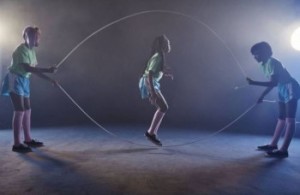I can now say that thanks to a Lifetime reality show something I wrote is a little bit less true. The four-episode Jump! about a double dutch team in New Jersey showed me that jump-roping has more to do with teamwork than I previously thought.

In Chapter 1 of Playing to Win I detail the historical evolution of competitive children's activities. I write, "By the 1960s more adults had become involved in these organizations, especially parents. Parents and kids spent time together at practices for sports that were part of a national structure: Biddy basketball, Pee Wee hockey, and Pop Warner football. Even nonteam sports were growing and developing their own formal, national-level organizations run by adults. For example, Double Dutch jump-roping started on playgrounds in the 1930s; in 1975 the American Double Dutch League was formed to set formal rules and sponsor competitions."
While the facts are true (many of which I took from Howard Chudacoff's 2007 book Children at Play: An American History, in Chapter 5), I learned by watching the Floyd Little team compete that double dutch is actually an "extreme sport for teamwork." That's because the turners and jumpers have to work together and communicate in order to succeed. That communication occurs not just in terms of their bodies, but often their language as they call out commands and counts to one another.
I learned a bit about double dutch by watching Jump!, but I was also left with many questions.
In many ways Jump! is similar to Bring It! (though I still have love for the show, it got very stale and formulaic this past season). Beyond the obvious-- that both activities are portrayed as being primarily made up of African-American girls who sport t-shirts with unique nicknames on them-- the series showcase a style of athletic dance that many outside of the subcultures don't know much about. As I wrote that I wasn't sure about "technique" in majorette dance, I don't know much about double dutch technique beyond the obvious "Don't step on the rope!" Because double dutch is difficult I would have loved to learn how both speed and tricks are taught, especially the timing. How much cardio do the jumpers do to prepare for two minutes of speed rounds? We primarily saw two categories of competition on the show, but are there others? And what about team sizes? Much more to mine here beyond the four episodes and the inherent drama of moms, daughters, coaches, and competition.
Some other observations:
*Teams wear uniforms for competitions, but no sparkles, which seems deliberate. Avoiding a non-athletic label? (Note that in NYC double dutch is considered a varsity sport) Given that I was surprised there isn't an accepted "double dutch" shoe or sneaker. How do competitors decide what shoes they like best? Learn to tie knots in their shoes that they are sure won't come out while jumping?
*Loved that they showed a girl (and her mom) wearing hijabs. Unlike many other girls' activities the lack of uniformity in dress and appearance may make this a more welcoming option? On a similar note, how much thought goes into hair styles when considering jumping; are braids heavier, no big hair, etc.?!
*As populations have migrated out of urban settings, has double dutch (originally a street game so strongly associated with cities) also migrated? We only saw urban teams on the show; do they dominate or is there an inequality we weren't shown?
*If Lifetime picks up this series for a second season they will have lots of drama to mine with Coach Quaniee daughter being on the team, and being one of the best. The old rivalries angle was also interesting. I assume the majority of coaches were themselves competitive jumpers in the day? If so, how many turners go on to coach?
*I wonder if Coaches Quaniee and Layla got their public school teaching jobs back?
This is the most I have seen since Disney made a 2007 movie called Jump In! starring Keke Palmer and Corbin Bleu. I'm wondering if it will spark a revival, especially given the potential health benefits. The combination of rhythm, dance, athleticism, artistic expression, teamwork yet individual distinction, and competition make it an appealing activity for both kids and adults interested in childhood well-being, including doctors, teachers and parents.
I for one would jump at the opportunity (yes, pun intended) to learn more about this world and hope someone can answer some of my questions!